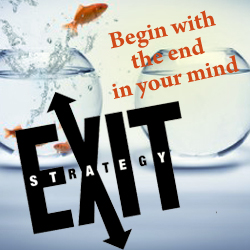
When it comes to setting up your business, there are several key elements that everyone has to consider. A start-up organisation needs to have a good understanding of the overall vision, the right strategy to facilitate goals and the correct processes to most efficiently implement that strategy. You need to consider what you hope to accomplish, what resources you will need to achieve those objectives and how best to allocate money and assets to secure financial success. That is why planning is so important at the inception of any business or company, no matter its size. However, one vital element that many people tend to overlook when setting up a business is the end game; in particular, your individual exit strategy in terms of your proposed business.
Excuse me?
Now bear with us. It might sound like an oxymoron to be highlighting the importance of determining your exit strategy before setting up your business, but in actual fact, it is a highly crucial step. Even the smallest of businesses do potentially drastic damage without the proper preparation and planning, which includes asking essential questions that will determine how you manage your structure and processes moving forward. As we discovered in a previous article, up to 80% of issues your business will face are attributed to breakdowns in, or a lack of correct, processes. Processes help your business function at the most efficient, most productive and most lucrative level and they will be determined by your strategy; which needs to take into account the vision you have for the lifecycle of the business.
Isn’t an exit strategy counter-productive?
Not at all. Exit strategies can take many forms, many of which are the result of business success, and only you will know which is right for you. When you think about your business and your vision for its success or growth, have you also considered its lifespan? Is it a long-term business that will hopefully have hundreds of employees one day? Is it a small outlet for a personal passion project? Is it something that will give you flexibility and a stable income? Perhaps it is an innovative start-up concept that will transform an element of life and become incredibly popular? Determining which of these is most appropriate will help you figure out your proposed exit strategy. It is also important to take into account your personal goals alongside your business-orientated ones. Succeeding in the framework of a life/work balance means avoiding unnecessary compromises to the areas that matter most to you. Perhaps you need to consider how you envision your future as an individual, will you want to avoid personal financial risk, spend more time with your family and loved ones, or achieve a particular status level? Examining your personal and professional objectives in tandem will further help you to create the ultimate strategy for success. To start with, you need to work out which exit is most likely to apply to your situation. There are three main types of exit strategy most commonly desired:
The Sell Exit – this is where your business concept or performance attracts the right level of attention and income to appeal to other competitors or larger organisations, enabling you to sell the business on for a profit. If you have a fantastic idea that you feel seals a gap in the market, this is the type of exit strategy that might appeal to you, especially if your dream is to retire early with enough money to enjoy life to the fullest.
The Hands-off Exit – this is when you see a future in which you would like to stay involved with the business, but with a much more hands-off management style; perhaps as a figure head or a more part-time role. This would apply for those who see their business with a long-term future, but don’t wish to spend their whole lives in the trenches. They would like to create an environment in which others can thrive and take over elements to allow for less regular involvement.
The Passive or Steady Income Exit – this is for those who would like to get their business to a place where it will generate enough income for them to step away and pursue other avenues, perhaps even ones that will not be financially beneficial. In this case, you might wish to spend some time in a more creative sphere, writing a book, designing clothes, cooking or fitness, all of which would require time and the financial resources to cover you not having an income. If you are still receiving profits from your business, but not having to manage it day-to-day, you have the time and resources to follow your dreams in a different direction.
Planning for the end is safer
The reality is that for businesses to protect themselves from failure, they need to embrace every level of proper planning. Without the right strategy and processes in place, you may find yourself struggling to achieve your personal, business or company goals further down the line. Small businesses that grow quickly without comprehensive and accurate process mapping could jeopardise a future sale or the potential for you to step away and have someone else take over. If you haven’t prepared for every function to be catered for in line with your business goals, smooth operations are at risk of breaking down, which will not help you successfully reach your preferred exit strategy and could dominate your time as you build the business overall.
Ask the right questions
One of the first things you ask yourself when considering starting a business is ‘what do I want to achieve?’. You might want to be the best in the market, invent something new, provide a higher level of service or be a wild disrupter. The next question is what are you willing/able to do in order to achieve your goal, what will you risk? As an individual this goal/cost analysis is vital to the way in which you determine your strategy, and your exit plan is a key part of that. What are your financial goals? How much personal investment are you willing to give? How much time are you willing to invest? What would your dream objective be in ten or twenty years’ time? How do you see your retirement? If you know the answers to these questions, you can better prepare the map to reach them and the items you will need on the journey. Smart business navigation is the easiest way to get to where you want to be with the least amount of issues, and having a coherent and relevant exit strategy will save you time, worry and money in the long run.
If you would like to get expert advice on aligning your company’s strategy to business processes and performance that will continually drive improvements and profitability, get in touch with Identify Action at https://identifyaction.com/ or via email on action@identifyaction.com.


Recent Comments